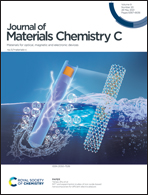Giant and anisotropic second harmonic generation of V–V binary phosphorene derivative with permanent dipole†
Abstract
Optical nonlinearity of two-dimensional (2D) materials with a permanent dipole is a subject of intense research in the fields ranging from all-optical signal processing to laser nanotechnology due to the potential outstanding performance of 2D materials in nonlinear optical processes, and the feasibility for extensive integration into optoelectronic devices. In the present work, the group-VA binary monolayers are predicted to have giant and broadband second harmonic generation (SHG) properties superior to some of the most popular NLO materials by first-principles calculations. The SHG susceptibility of the α-PAs reaches up to 8.0 × 106 pm2 V−1, which is nearly 1–2 orders of magnitude higher than that of honeycomb monolayer MoS2 and h-BN, and twice larger than the record-high SHG susceptibility of a 2D ferroelectric GeSe monolayer. This intriguing peak is formed by intraband two photon transition ascribed to the relatively small bandgap and large transition matrix elements between valence and conduction band edges. A high-performance nonlinear optical device can be developed using those 2D group-VA monolayer materials with puckled structure and in-plane polarizabilities for multifunctional and integrated optoelectronic applications.



 Please wait while we load your content...
Please wait while we load your content...